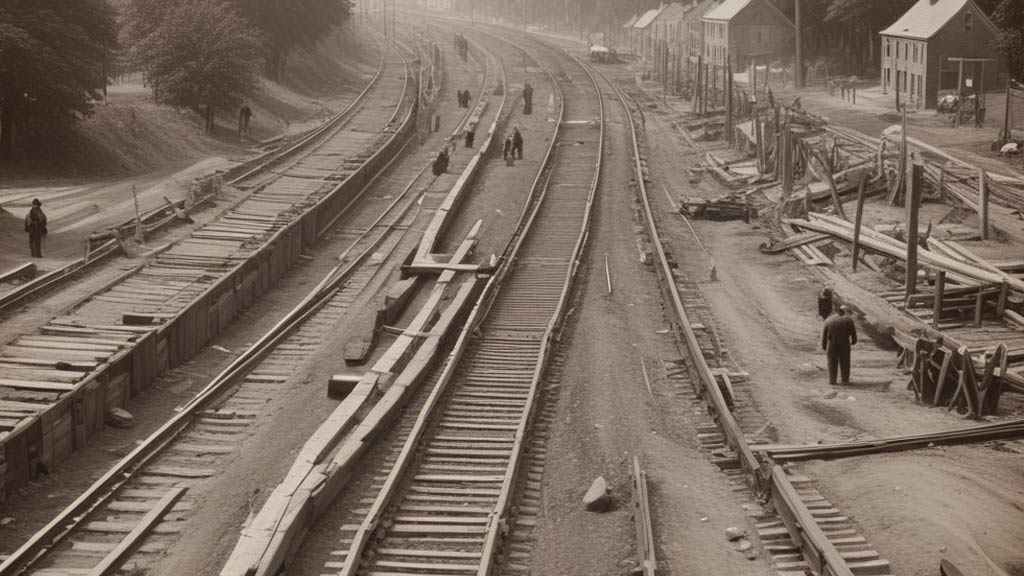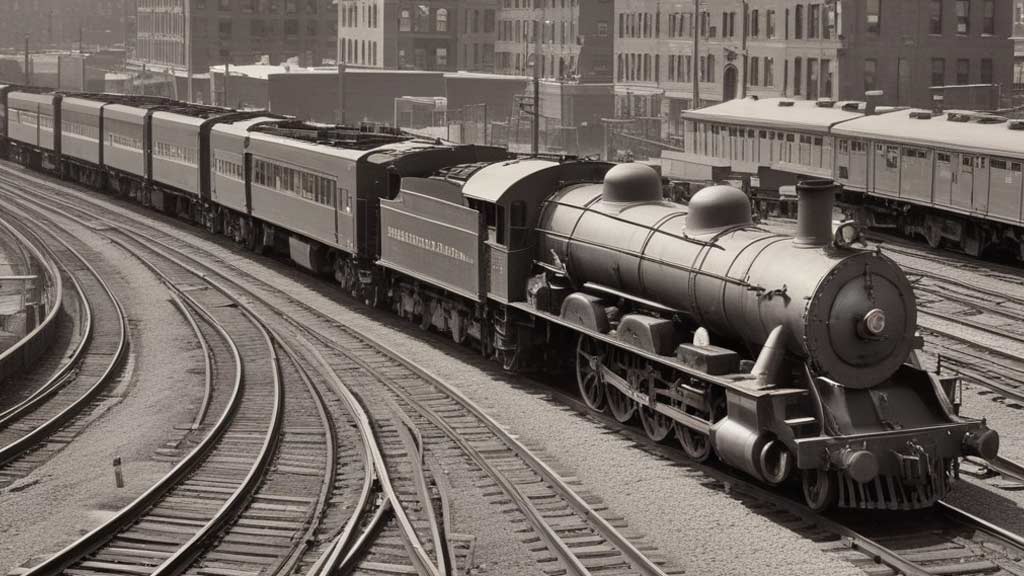The history of the Providence and Worcester Railroad (PW) is a narrative woven with ambition, innovation, and the relentless pursuit of progress.
From its humble beginnings in the mid-19th century to its present-day prominence, PW’s story is emblematic of the transformative power of rail transportation in shaping the economic and social fabric of the Northeastern United States.
Established through the merger of two state-chartered companies in 1845, PW quickly emerged as a vital conduit for commerce between the cities of Providence and Worcester.
Over the decades, it expanded its network, forged strategic partnerships, and navigated through challenges, cementing its status as a cornerstone of regional transportation infrastructure.
Today, PW stands as a testament to resilience and adaptability in an ever-evolving industry landscape.
Timeline of Providence and Worcester Railroad History
Established in 1844, PW Railroad played a pivotal role in New England’s transportation landscape.
Explore its rich history through key milestones:
Incorporation and Merger (1844-1845)
The Providence and Worcester Railroad (PW) was the culmination of visionary efforts in the mid-19th century to enhance transportation links between key cities in Massachusetts and Rhode Island.
The decision to merge two state-chartered companies in 1845 was motivated by the recognition of the economic benefits that a rail connection between Providence and Worcester would bring.
This merger not only consolidated resources but also streamlined administrative processes, laying the groundwork for PW’s future expansion and success.
Main Line Construction (1845-1847)

The construction of PW’s main line between Providence and Worcester was a monumental undertaking that required significant planning, engineering expertise, and labor.
By acquiring portions of the Blackstone Canal, PW repurposed existing infrastructure to expedite the construction process.
The completion of the main line in two phases within a span of two years not only showcased PW’s organizational capabilities but also underscored its commitment to meeting the growing demand for reliable transportation services in the region.
Collaboration with Boston and Providence Railroad (1847)
PW’s collaboration with the Boston and Providence Railroad in 1847 was a strategic maneuver aimed at maximizing operational efficiency and extending market reach.
By sharing rail lines, both companies capitalized on synergies to enhance connectivity between Providence and Boston, fostering increased trade and commerce along their respective routes.
This collaborative effort also underscored the spirit of cooperation and mutual benefit that characterized the railroad industry during this period of expansion and growth.
Expansion to East Providence (1874)
The decision to expand PW’s network to East Providence in 1874 was driven by emerging opportunities in the transportation of coal and other commodities.
Constructing a branch line to the Wilkesbarre Pier not only provided PW with access to a lucrative market but also solidified its position as a vital link in the regional supply chain.
The expansion into East Providence marked a strategic move that diversified PW’s revenue streams and strengthened its overall competitive position in the marketplace.
Lease Agreements (1889-1970)

Throughout its history, PW engaged in various lease agreements with other railroads, reflecting the dynamic nature of the industry and the evolving business landscape.
The decision to enter into lease agreements, notably with the New York, Providence, and Boston Railroad, and later with the New York, New Haven, and Hartford Railroad, was often driven by strategic considerations aimed at enhancing operational efficiency, expanding market reach, or accessing additional resources.
While these lease agreements presented opportunities for growth, they also posed challenges, particularly during periods of economic uncertainty and industry consolidation.
Independence and Growth (1970-1982)
Achieving independence in 1970 marked a significant milestone in PW’s history, empowering the railroad to chart its own course and pursue opportunities for growth and expansion.
In the ensuing years, PW capitalized on its newfound autonomy to pursue strategic acquisitions and investments, acquiring lines from entities like Penn Central and Boston and Maine Railroad.
This period of growth not only expanded PW’s operational footprint but also solidified its position as a leading transportation provider in the Northeast region.
Expansion into Connecticut (1976)
The decision to expand into Connecticut in 1976 represented a strategic move to capitalize on emerging market opportunities and diversify PW’s revenue streams.
By nearly tripling its operating territory, PW significantly expanded its market reach and enhanced its ability to serve a broader customer base.
This expansion into Connecticut not only strengthened PW’s competitive position but also positioned the railroad for sustained growth and success in the years to come.
Assumption of Conrail Operations (1982)
Assuming all rail freight operations in Rhode Island previously managed by Conrail in 1982 was a transformative moment for PW, further solidifying its position as a key player in the regional rail freight sector.
By consolidating operations and optimizing efficiency, PW was able to streamline its operations and better serve the needs of its customers.
This strategic move also underscored PW’s commitment to providing reliable and efficient transportation solutions while cementing its reputation as a trusted partner in the communities it served.
Current Operations (Present)
Today, PW continues to play a vital role in the transportation infrastructure of the Northeast region, serving as a critical link in the supply chain for a wide range of industries.
With approximately 516 miles of track spanning multiple states, PW remains committed to providing safe, reliable, and efficient transportation services to its customers.
Through ongoing investments in technology, infrastructure, and workforce development, PW is well-positioned to meet the evolving needs of its customers and contribute to the economic growth and prosperity of the communities it serves.
FAQs
What Is the Oldest Railroad Company in America?
The Baltimore and Ohio Railroad (B&O) holds the distinction of being the oldest railroad company in America.
Chartered in 1827, the B&O played a significant role in the development of the American railroad industry and the expansion of transportation infrastructure in the early 19th century.
What Year Was the Providence and Worcester Railroad Established?
Providence and Worcester Railroad (PW) was incorporated in Massachusetts in 1844 and in Rhode Island during the May session of the General Assembly in the same year.
When Was PW’s Main Line Construction Completed?
PW completed the construction of its main line between Providence and Worcester in two phases, with the southern section finished on September 27, 1847, and the remainder on October 20, 1847.
What Significant Collaboration Did PW Have in 1847?
In 1847, PW collaborated with the Boston and Providence Railroad, sharing rail lines to extend the latter’s presence into Rhode Island, enhancing regional connectivity and economic development.
What Event Marked PW’s Independence?
PW achieved independence in 1970, separating from the Penn Central Transportation Company, and commenced independent operations, marking a significant milestone in its history.
Wrap Up
The history of the Providence and Worcester Railroad (PW) is a saga of perseverance, innovation, and enduring significance.
From its inception in the mid-19th century to its current standing as a vital player in regional transportation, PW has exemplified resilience in the face of challenges and adaptability in an evolving landscape.
Through strategic expansion, collaborative ventures, and a steadfast commitment to service excellence, PW has woven itself into the fabric of the Northeastern United States, facilitating commerce, connecting communities, and driving economic growth.
As it continues to evolve in response to changing needs and technologies, PW remains a testament to the enduring legacy of railroads in shaping the past, present, and future of our nation.
Jaclyn Lowe